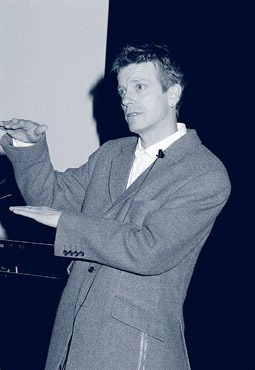Cinesonic 4: bringing sound to the surface
Bruce Mowson

Simon Fisher-Turner
photo John Bilan
Simon Fisher-Turner
One of the comments most often made of film soundtracks is “I didn’t even notice it.” Sometimes this is considered a compliment. Sound is one of the cinema’s most powerful tools, whereby the audience is influenced from below the radar of their consciousness. This is the potent territory explored at the Cinesonic 4 conference, held at the Treasury Theatre in Melbourne.
The Potency of the Soundtrack
This potency is employed in subtle ways, as demonstrated by McKenzie Wark (Macquarie University, Sydney) in clips from E.R. where the beeps, sucks and hisses of life support equipment are orchestrated to create tension with the dialogue. On the other hand, the soundtrack can be turned on its head to reveal the voices it excludes. In Hollywood, the sound of the voice is regulated by the “Hollywood Accent”, from which directors rarely deviate (hear the regional accents in the Coen Brothers’ Fargo for an exception to the rule). Megan Spencer’s (documentary maker/film reviewer, Triple J) presentation “Shout It Out Loud: The Voice of the Documentary Subject” identifies distinctions between the heard and unheard. Megan gives voice to the invisibles: Benjamin Smoke’s croaking, tobacco stained timbres; the speech of ex-inmates struggling with the sound of their voices outside a prison’s reverberant confines; and most bizarrely and beautifully in A Pair of One, identical twins whose voices switch between a call-and-response of identical parts and a perfectly matched unison, as they begin, echo and end each other’s thoughts. Megan’s presentation gives rise to intriguing questions about the relationship between the subject and writer or director: who is speaking through whom?
Language, Nationalism/ Regionalism and Realism
As sound came to the screen, so did nationalism. While silent film spoke mainly with pictures, the voice in the talkies spoke in nationalised languages. It may be that Indian cinema relies so heavily on music because it speaks more universally to an audience divided into more than 300 languages. Kathryn Bird (multimedia producer, Melbourne) describes the effect of this in Hong Kong cinema, where actors, crew and audiences are divided into Cantonese or Mandarin speakers, necessitating complicated dubbing and translation. Extensions of this sonic nationalism, or regionalism, are apparent in further clips from Hong Kong films. Precedence is given to materialising the sound of bodies and objects moving in air, and music is pushed to the background, occupying the space cicadas would in a Hollywood film. An inversion of this sonic ordering came from Philip Brophy (lecturer, Mars) playing a scene from Flashdance where Irene Cara’s body flies through the air and the sound of the physical world is dissolved by the soaring hit single What a Feeling.
Any lingering ideas of the possibility of authentic cinematic realism are dispelled by Ashish Rajadhyaksha’s (film theorist, Bombay) tracing of differences between Indian and western cinema back to their roots in India’s 2 dimensional or flat pictorial representations and western vanishing point perspective. Ashish also explains how the conventionally flat, overdubbed voice in Indian cinema refers to a traditional relationship between the deity and devotee, in which the deity’s voice always issues from a frontal perspective. Interestingly, the phenomenon of the voiceover in western cinema is not given such mystic connotations, though the origin of this omnipotent voice can be explored. In contrast to these metaphysical allusions are Bruce Lee’s animalistic battle cries, discussed by Kathryn Bird, which collapse language, narrative and material into a cinematic inscription of a body’s energy.
Film production
Given that a film is an embodiment of the energies that produced it, the poetics of Derek Jarman’s films were also present in his life and in the methods by which he made his films. This poetry is also made manifest by Simon Fisher-Turner (England), score composer of many of Jarman’s films. Simon intuitively understands the difference between music and music-for-pictures and, handed complete creative freedom by Jarman, worked totally outside the Hollywood model of temp tracks, audience testing and producer’s final approvals. Simon’s unorthodox presentation is an antidote to the regimented and often neurotic world of filmmaking, and proves that it’s possible to have a successful creative career outside the accepted models of professional practice. A direct contrast to this comes from Skip Lievsay (New York-based sound designer for the Coen Brothers, Martin Scorsese and Spike Lee) who demonstrates that you can make great soundtracks by working completely within industry conventions.
For the attuned listener, the soundtrack is a rich and detailed terrain of sound and music. Film sound theory, however, is underdeveloped. Texts such as Michel Chion’s Audiovision, which investigates the unexplored reaches of the soundtrack and its relationship to images, develop new terminology, filling the critical void. So too does Cinesonic 4: Between Sound and Music.
Cinesonic: 4th International Conference on film scores and sound design, Cinemedia, Treasury Theatre, Melbourne, June 22-24. Cinesonic 3: Experiencing the Soundtrack is now available in paperback through AFTRS
RealTime issue #44 Aug-Sept 2001 pg. 22






